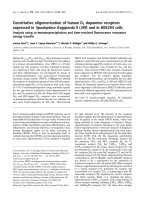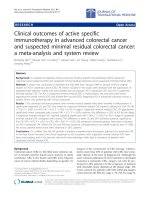Topics in dynamic model analysis : advanced matrix methods and unit root econometrics representation theorems
Bạn đang xem bản rút gọn của tài liệu. Xem và tải ngay bản đầy đủ của tài liệu tại đây (4.28 MB, 152 trang )
www.pdfgrip.com
Lecture Notes in Economics
and Mathematical Systems
Founding Editors:
M. Beckmann
H. P. Kunzi
Managing Editors:
Prof. Dr. G. Fandel
FachbereichWirtschaftswissenschaften
Femuniversitat Hagen
Feithstr. 140/AVZII, 58084 Hagen, Germany
Prof. Dr. W. Trockel
Institut fur Mathematische Wirtschaftsforschung (IMW)
Universitat Bielefeld
Universitatsstr. 25, 33615 Bielefeld, Germany
Editorial Board:
A. Basile, A. Drexl, H. Dawid, K. Inderfurth, W. Kursten, U. Schittko
558
www.pdfgrip.com
Mario Faliva
Maria Grazia Zoia
Topics in Dynamic
Model Analysis
Advanced Matrix Methods and Unit-Root
Econometrics Representation Theorems
Spri
ringer
www.pdfgrip.com
Authors
Prof. Mario Faliva
Full Professor of Econometrics and
Head of the Department of Econometrics
and Applied Mathematics
Faculty of Economics
Catholic University of Milan
Largo Gemelli, 1
1-20123 Milano, Italy
Prof. Maria Grazia Zoia
Associate Professor of Econometrics
Faculty of Economics
Catholic University of Milan
Largo Gemelli, 1
1-20123 Milano, Italy
Library of Congress Control Number: 2005931329
ISSN 0075-8442
ISBN-10 3-540-26196-6 Springer Berlin Heidelberg New York
ISBN-13 978-3-540-26196-4 Springer Berlin Heidelberg New York
This work is subject to copyright. All rights are reserved, whether the whole or part
of the material is concerned, specifically therightsof translation, reprinting, re-use of
illustrations, recitation, broadcasting, reproduction on microfilms or in any other way,
and storage in data banks. Duplication of this publication or parts thereof is permitted
only under the provisions of the German Copyright Law of September 9,1965, in its
current version, and permission for use must always be obtained from Springer-Verlag.
Violations are liable for prosecution under the German Copyright Law.
Springer is a part of Springer Science+Business Media
springeronline.com
© Springer-Veriag Beriin Heidelberg 2006
Printed in Germany
The use of general descriptive names, registered names, trademarks, etc. in this
publication does not imply, even in the absence of a specific statement, that such
names are exempt from the relevant protective laws and regulations and therefore
free for general use.
Typesetting: Camera ready by author
Cover design: Erich Kirchner, Heidelberg
Printed on acid-free paper
42/3130J6
5 4 3 2 10
www.pdfgrip.com
To Massimiliano
To Giulia and Sofia
www.pdfgrip.com
Preface
Classical econometrics - which plunges its roots in economic theory
with simultaneous equations models (SEM) as offshoots - and time series
econometrics - which stems from economic data with vector autoregressive (VAR) models as offsprings - scour, like the Janus's facing heads, the
flowing of economic variables so as to bring to the fore their autonomous
and non-autonomous dynamics. It is up to the so-called final form of a dynamic SEM, on the one hand, and to the so-called representation theorems
of (unit-root) VAR models, on the other, to provide informative closed
form expressions for the trajectories, or time paths, of the economic variables of interest.
Should we look at the issues just put forward from a mathematical
standpoint, the emblematic models of both classical and time series
econometrics would turn out to be difference equation systems with ad hoc
characteristics, whose solutions are attained via a final form or a representation theorem approach. The final form solution - algebraic technicalities
apart - arises in the wake of classical difference equation theory, displaying besides a transitory autonomous component, an exogenous one along
with a stochastic nuisance term. This follows from a properly defined matrix function inversion admitting a Taylor expansion in the lag operator because of the assumptions regarding the roots of a determinant equation peculiar to SEM specifications.
Such was the state of the art when, after Granger's seminal work, time
series econometrics came into the limelight and (co)integration burst onto
the stage. While opening up new horizons to the modelling of economic
dynamics, this nevertheless demanded a somewhat sophisticated analytical
apparatus to bridge the unit-root gap between SEM and VAR models.
Over the past two decades econometric literature has by and large given
preferential treatment to the role and content of time series econometrics as
such and as compared with classical econometrics. Meanwhile, a fascinating - although at time cumbersome - algebraic toolkit has taken shape in a
sort of osmotic relationship with (co)integration theory advancements.
The picture just outlined, where lights and shadows - although not explicitly mentioned - still share out the scene, spurs us on to seek a deeper
insight into several facets of dynamic model analysis, whence the idea of
www.pdfgrip.com
VIII
Preface
this monograph devoted to representation theorems and their analytical
foundations.
The book is organised as follows.
Chapter 1 is designed to provide the reader with a self-contained treatment of matrix theory aimed at paving the way to a rigorous derivation of
representation theorems later on. It brings together several results on generalized inverses, orthogonal complements, partitioned inversion rules
(some of them new) and investigates the issue of matrix polynomial inversion about a pole (in its relationships with difference equation theory) via
Laurent expansions in matrix form, with the notion of Schur complement
and a newly found partitioned inversion formula playing a crucial role in
the determination of coefficients.
Chapter 2 deals with statistical setting problems tailored to the special
needs of this monograph . In particular, it covers the basic concepts on stochastic processes - both stationary and integrated - with a glimpse at
cointegration in view of a deeper insight to be provided in the next chapter.
Chapter 3, after outlining a common frame of reference for classical and
time series econometrics bridging the unit-root gap between structural and
vector autoregressive models, tackles the issue of VAR specification and
resulting processes, with the integration orders of the latters drawn from
the rank characteristics of the formers. Having outlined the general setting,
the central topic of representation theorems is dealt with, in the wake of
time series econometrics tradition named after Granger and Johansen (to
quote only the forerunner and the leading figure par excellence), and further developed along innovating directions thanks to the effective analytical toolkit set forth in Chapter 1.
The book is obviously not free from external influences and acknowledgement must be given to the authors, quoted in the reference list, whose
works have inspired and stimulated the writing of this book.
We should like to express our gratitude to Siegfried Schaible for his encouragement about the publication of this monograph.
Our greatest debt is to Giorgio Pederzoli, who read the whole manuscript and made detailed comments and insightful suggestions.
We are also indebted to Wendy Farrar for her peerless checking of the
text.
Finally we would like to thank Daniele Clarizia for his painstaking typing of the manuscript.
Milan, March 2005
Mario Faliva and Maria Grazia Zoia
Istituto di Econometria e Matematica
Universita Cattolica, Milano
www.pdfgrip.com
Contents
Preface
VII
1 The Algebraic Framework of Unit-Root Econometrics
1.1 Generalized Inverses and Orthogonal Complements
1.2 Partitioned Inversion: Classical and Newly Found Results ,
1.3 Matrix Polynomials: Preliminaries.......
1.4 Matrix Polynomial Inversion by Laurent Expansion
1.5 Matrix Polynomials and Difference Equation Systems...
1.6 Matrix Coefficient Rank Properties vs. Pole Order in Matrix
Polynomial Inversion
1.7 Closed-Forms of Laurent Expansion Coefficient Matrices
1
1
10
16
19
.24
30
37
2 The Statistical Setting
53
2.1 Stochastic Processes: Prehminaries
.........53
2.2 Principal Multivariate Stationary Processes
...56
2.3 The Source of Integration and the Seeds of Cointegration..
68
2.4 A Glance at Integrated and Cointegrated Processes
71
Appendix. Integrated Processes, Stochastic Trends and Role
of Cointegration
77
3 Econometric Dynamic Models: from Classical Econometrics
to Time Series Econometrics
79
3.1 Macroeconometric Structural Models Versus VAR Models
79
3.2 Basic VAR Specifications and Engendered Processes
..85
3.3 A Sequential Rank Criterion for the Integration Order of a VAR
Solution.
90
3.4 Representation Theorems for Processes / ( I )
...97
3.5 Representation Theorems for Processes / (2)
110
3.6 A Unified Representation Theorem....
128
Appendix. Empty Matrices....
131
References
133
Notational Conventions, Symbols and Acronyms
137
www.pdfgrip.com
X
Contents
List of Definitions
139
List of Theorems, Corollaries and Propositions
141
www.pdfgrip.com
1 The Algebraic Framework of Unit-Root
Econometrics
Time series econometrics is centred around the representation theorems
from which one can evict the integration and cointegration characteristics
of the solutions for the vector autoregressive (VAR) models.
Such theorems, along the path established by Engle and Granger and by
Johansen and his school, have promoted the parallel development of an
"ad hoc" analytical implement - although not always fully settled.
The present chapter, by reworking and expanding some recent contributions due to Faliva and Zoia, provides in an organic fashion an algebraic
setting based upon several interesting results on inversion by parts and on
Laurent series expansion for the reciprocal of a matrix polynomial in a deleted neighbourhood of a unitary root. Rigorous and efficient, such a technique allows for a quick and new reformulation of the representation theorems as it will become clear in Chapter 3.
1.1 Generalized Inverses and Orthogonal Complements
We begin by giving some definitions and theorems on generalized inverses. For these and related results see Rao and Mitra (1971), Pringle and
Rayner (1971), S.R. Searle (1982).
Definition 1
A generalized inverse of a matrix A of order m x n is a matrix A of order nxm such that
AAA=A
(1)
The matrix A is not unique unless A is a square non-singular matrix.
We will adopt the following conventions
B=A
to indicate that fi is a generalized inverse of A;
(2)
www.pdfgrip.com
2
1 The Algebraic Framework of Unit-Root Econometrics
A=B
(3)
to indicate that one possible choice for the generalized inverse of A is
given by the matrix B.
Definiton 2
The Moore-Penrose generalized inverse of a matrix A of order m x n is a
matrix A^ of order nxm such that
AA'A=A
(4)
A'AA' = A'
(5)
(AAy=AA'
(6)
(A'AY = A'A
(7)
where A' stands for the transpose of A. The matrix A^ is unique.
Definition 3
A right inverse of a matrix A of order mx n and full row-rank is a matrix A~ of order nxm such that
AA; = I
(8)
Tiieorem 1
The general expression of A~ is
A; =H'(AHy
(9)
where H is an arbitrary matrix of order mxn such that
det(AH')itO
(10)
Proof
For a proof see Rao and Mitra (1971, Theorem 2.1.1).
D
www.pdfgrip.com
1 o 1 Generalized Inverses and Orthogonal Complements
3
Remark
By taking ^ = A, we obtain
A; =A'{AAy^A\
(11)
a particularly useful form of right inverse.
Definition 4
A left inverse of a matrix A of order mxn and full column-rank is a matrix A~ of order nxm such that
A;A=I
(12)
Thieorem 2
The general expression of A~ is
A; =(JCAyK'
(13)
where /iT is an arbitrary matrix of order mxn such that
det(K'A)^0
(14)
Proof
For a proof see Rao and Mitra (1971, Theorem 2.1.1).
D
Remarl(
By letting liT = A, we obtain
A; =(A'AyA' ^A'
(15)
a particularly useful form of left inverse.
We will now introduce the notion of rank factorization.
Thieorem 3
Any matrix A of order mxn and rank r may be factored as follows
A=BC
(16)
www.pdfgrip.com
4
1 The Algebraic Framework of Unit-Root Econometrics
where B is of order m x r, C is of order nx r, and both B and C have rank
equal to r.
Such a representation is known as a rank factorization of A.
Proof
For a proof see Searle (1982, p. 194).
D
Theorem 4
Let a matrix A of order mxn and rank r be factored as in (16). Then A
can be factored as
A= (CX B-
(17)
with the noteworthy relationship
CAB = I
(18)
as a by-product.
In particular, the Moore-Penrose inverse A^ can be factored as
A' = (CJB' = C (CC)-' (BB)' B'
(19)
Proof
The proofs of both (17) and (18) are simple and are omitted. For a proof
of (19) see Greville (1960).
D
We shall now introduce some further definitions and establish several
results on orthogonal complements. For these and related results see Thrall
and Tomheim (1957), Lancaster and Tismenetsky (1985), Lutkepohl
(1996) and the already quoted references.
Definition 5
The row kernel, or null row space, of a matrix A of order mxn and rank
r is the space of dimension (m - r) of all solutions x of jc' A' = 0\
www.pdfgrip.com
1.1 Generalized Inverses and Orthogonal Complements
5
Definition 6
An orthogonal complement of a matrix A of order mxn and full column-rank is a matrix A± of order mx(m-n)
and full column-rank such
that
A[A = 0
(20)
Remarl^
The matrix A± is not unique. Indeed the columns of A_L form not only a
spanning set, but even a basis for the rovs^ kernel of A and the other way
around. In light of the foregoing, a general representation of the orthogonal
complement of a matrix A is given by
A^=AV
(21)
where A is a particular orthogonal complement of A and V is an arbitrary
square non-singular matrix connecting the reference basis (namely, the
m-n columns of A) to an another (namely, the m-n columns of AV) .
The matrix V is usually referred to as a transition matrix between bases
(cf. Lancaster and Tismenetsky, 1985, p. 98).
We shall adopt the following conventions:
A = A^
(22)
to indicate that A is an orthogonal complement of A;
A^=A
(23)
to indicate that one possible choice for the orthogonal complement of A is
given by the matrix A,
The equality
(Ai)^=A
(24)
reads accordingly.
We now prove the following in variance theorem
Ttieorem 5
The expressions
A^iH'A^r
(25)
www.pdfgrip.com
6
1 The Algebraic Framework of Unit-Root Econometrics
C^(B[KC^rB[
(26)
and the rank of the partitioned matrix
J
B^
C[
0
(27)
are invariant for any choice of Ax, B± and Cj., where A, B and C are full
column-rank matrices of order m x n, H is an arbitrary full column-rank
matrix of order mx{m-n)
such that
det{H'Aj_)^0
(28)
and both / and K, of order m, are arbitrary matrices, except that
det(B[KCjL)^0
(29)
Proof
To prove the invariance of the matrix (25) we check that
A^, (H'A^y - A^, {H'A^,r = 0
(30)
where A^j and A^^ are two choices of the orthogonal complement of A.
After the arguments put forward to arrive at (21), the matrices A^^ and
A^2 ^r^ linked by the relation
A,,^A^,V
(31)
for a suitable choice of the transition matrix F.
Substituting A^j V for A^^ in the left-hand side of (30) yields
A,, {HA,,r
- A„ V{H'A,yy
-A,,W\H'A^,y
= A„
iHA,,r
=0
which proves the asserted invariance.
The proof of the invariance of the matrix (26) follows along the same
lines as above by repeating for B± and C± the reasoning used for Ax.
The proof of the invariance of the rank of the matrix (27) follows upon
noticing that
www.pdfgrip.com
1.1 Generalized Inverses and Orthogonal Complements
fix12 ^
/
= r
0
BuVr
=r
<^l2
/
r
7
0
/2^11
B
J
0 v:
I 0
-ly
J
= r
0 Vi j y
(33)
B
VL^ii
where V ^^^ V ^^e suitable choices of transition matrices.
D
The following theorem provides explicit expressions for orthogonal
complements of matrix products, which find considerable use in the text.
Theorem 6
Let A and B be full column-rank matrices of order I x m and m x n respectively. Then the orthogonal complement of the matrix product AB can
be expressed as
(AB)^ = [(AyB^,AjJ
(34)
In particular if / = m, then the following holds
(AB)^ = (AyB^
(35)
Moreover, if C is any non-singular matrix of order m, then we can write
(BC)^ = B^
(36)
(ABy[(AyB^,An = 0
(37)
Proof
Observe that
and that the block matrix
[(AyB,_,A^,AB]
(38)
is square and of full rank. Hence the matrix [(Ay B±, A±\ provides an explicit expression for the orthogonal complement of AJB, according to Definition 6 (see also Faliva and Zoia, 2003).
The result (35) is established by straightforward computation.
The result (36) is easily proved and rests on the arguments underlying
the representation (21) of orthogonal complements,
D
www.pdfgrip.com
8
1 The Algebraic Framework of Unit-Root Econometrics
The next three theorems provide expressions for generalized and regular
inverses of block matrices and related results of major interest for our analysis.
Theorem 7
Suppose that A and B are as in Theorem 6. Then
[(A'yflx,Ax]-=
BIA'
Ai
[(AyB^,AJ
=
(39)
((A'YBJ
(40)
Af
Proof
The results follow from Definitions 1 and 2 by applying Theorems 3.1
and 3.4, Corollary 4, in Pringle and Rayner (1971) p. 38.
D
Theorem 8
The inverse of the composite matrix [A, A^_] can be written as follows
[A,AjJ' =
Ai
(41)
which, in turns, leads to the noteworthy identity
AA' + A^Al =1
(42)
Proof
The proof is a by-product of Theorem 3.4, Corollary 4, in Pringle and
Rayner (1971), and the identity (42) ensues from the commutative property
of the inverse.
D
The following theorem provides a useful generalization of the identity
(42).
www.pdfgrip.com
1.1 Generalized Inverses and Orthogonal Complements
9
Theorem 9
Let A and B be full column-rank matrices of order mxn and mx(m-n)
respectively, such that the composite matrix [A, B] is non singular. Then,
the following identity
A(B[A)'B[
+ BiA[ByA[
=I
(43)
holds true.
Proof
Observe that insofar as the square matrix [A, B] is non-singular, both
B[A and A[ B are non-singular matrices also.
Furthermore, verify that
[A,
B]=
(A;B)-'A:J
This show^s that
In
0
0
L..
(44)
is the inverse of [A, B]. Hence the iden-
{A[BrA[
tity (43) follows from the commutative property of the inverse.
D
Let us now quote a few identities which can easily be proved because of
Theorems 4 and 8
AA' = BB'
(45)
A'A = (Cy C
(46)
I^-AA' = I^-BB^ = BABJ={B'J B[
(47)
I- A'A = / - (CO* c' = (C[y c[ = c^icj
(48)
where A, B and C are as in Theorem 3.
To conclude this section, let us observe that an alternative definition of
orthogonal complement - which differs slightly from that of Definition 6 may be more conveniently adopted for square singular matrices as indicated in the next definition.
www.pdfgrip.com
10
1 The Algebraic Framework of Unit-Root Econometrics
Definition 7
Let A be a square matrix of order n and rank r
A/", such that
A^A = 0
r([A;^,A])=:n
(49)
(50)
Analogously, a right-orthogonal complement of A is a square matrix of
order n and rank n-r, denoted by A^, such that
AA^=0
(51)
r([A,A^])^n
(52)
Suitable choices for the matrices A^ and A^ turn out to be the idempotent matrices (see, e.g., Rao, 1973)
A^=I-AA'
(53)
A^=I-A'A
(54)
which will henceforth simply be denoted by A^ and A^, respectively,
unless otherwise stated.
1.2 Partitioned Inversion: Classical and Newly Found Results
This section, after recalling classic results on partitioned inversion, presents newly found (see, in this regard, Faliva and Zoia, 2002a) inversion
formulas which, like Pandora's box, provide the keys to an elegant and
rigorous approach to unit-root econometrics main theorems, as shown in
Chapter 3.
To begin with we recall the following classical result:
Ttieorem 1
Let A and D be square matrices of order m and n, respectively, and let B
and C be full column-rank matrices of order mxn.
Consider the partitioned matrix
www.pdfgrip.com
1.2 Partitioned Inversion: Classical and Newly Found Results
A
B
C
D
P=
11
(1)
Then anyone of the following sets of conditions is sufficient for the existence of P"^
a) Both A and its Schur complement E = D- CA~^B are non-singular matrices.
b) Both D and its Schur complement F =A- BD^C are non-singular matrices.
Moreover the results listed below hold true:
/) Under a), the partitioned inverse of P can be written as
A" +A'BE'CA'
r
-A'BE'
=
(2)
-^ECA'
E'
ii) Under b), the partitioned inverse of P can be written as
F'
r' = -D'CF'
-F'BD'
(3)
D'
+D'CF'BD'
Proof
The matrix P"* exists insofar as (see Rao, 1973, p. 32)
\det{A)det{E) ^ 0, under a)
detiP) = l
[det(D)det(F) i^ 0, under b)
(4)
The partitioned inversion formulas (2) and (3), under the assumptions a)
and b), respectively, are standard results of the algebraic tool-kit of econometricians (see, e.g., Goldberger, 1964; Theil, 1971; Faliva, 1987).
D
We shall now establish the main result (see also Faliva and Zoia,
2002 a).
Theorem 2
Consider the block matrix
www.pdfgrip.com
12
1 The Algebraic Framework of Unit-Root Econometrics
A
B
C
0
P=
(5)
where A, B and C are as in Theorem 1.
The condition
det{B'^AC^)itQ
(6)
is necessary and sufficient for the existence oiR\
Further, the following representations of P"^ hold
H
r'=
(I-HA)iCy
B'{I-AH)
B'{AHA-A){Cy_
(7)
where
(8)
and
H
r'=
KiC'K)'
{KB) k'
-{KB)
k'AKiC'KY
(9)
where
K={A'B^)^
(10)
^=(ACx)i
(11)
Proof
Condition (6) follows from the rank identity (see Marsaglia and Styan,
1974, Theorem 19)
r{P) = r{B) + r{Q + r [{I-BB')A
{I-{CJC)]
= n + n + r[{B'jB[A
Ci(Cx)*] = 2n + r{B[ACA_)
(12)
where use has been made of the identities (47) and (48) of Section 1.1.
To prove (7), let the inverse of P be
p
p
r' = P
P
(13)
www.pdfgrip.com
1.2 Partitioned Inversion: Classical and Newly Found Results
13
where the blocks in R^ are of the same order as the corresponding blocks
in P. Then, in order to express the blocks of the former in terms of the
blocks of the latter, write R^P = / and PR^ -I'm partitioned form
B
K
0
A P* \[c 0
0
h_
K
0'
0
h_
Pi
A
P2 \\A
B] \Pi Pz
c o\ U ^4.
(14)
(15)
and equate block to block as follows
r
P,A + P,C' = I„
(16)
P^B = 0
(17)
P,A + P,C' = 0
(18)
<
P.B = I„
I
r
(19)
AP,+BP,=I„
(160
AP^ + BP^=0
(17')
C'P^=0
(18')
L c%=i„
(19')
From (16) and (16') we get
p, = {cj- p, A {cy = {i- p^) {cy
(20)
P^ = B' -B'AP^ = BU I- AP,)
(21)
respectively.
From (170, in Ught of (20) we can write
P, = - B'AP^ = -B'A [(CJ - P,A (CJ] = B' [AP^A -A](Cy
(22)
Consider now the equation (17). Solving for P^ gives
P, = V B :
(23)
for some V. Substituting the right-hand side of (23) for P^ in (16) and
postmultiplying both sides by C± we get
www.pdfgrip.com
14
1 The Algebraic Framework of Unit-Root Econometrics
VB[AC^ = C^
(24)
which solved for V yields
V=C^(B[ACJ-'
(25)
in view of (6).
Substituting the right-hand side of (25) for V in (23) we obtain
P^ = C^(B[ACd'B[
(26)
Hence, substituting the right-hand side of (26) for P^ in (20), (21) and
(22) the expressions of the other blocks are easily found.
The proof of (9) follows as a by-product of (7), in light of identity (43)
of Section 1.1, upon noticing that, on the one hand
I-AH
= I-(ACd(B[(AC^)rB[
=
=
B(tB)'K'
B((ACX)B\ACX
whereas, on the other hand,
I-^HA=K(CK)'C
(28)
D
The following corollaries provide further results whose usefulness will
soon become apparent.
Corollary 2,1
Should both assumptions a) and b) of Theorem 1 hold, then the following equality
(A ~ BD'cy
= A-' + A'B (D - CAByCA'
(29)
ensues.
Proof
Result (29) arises from equating the upper diagonal blocks of the righthand sides of (2) and (3).
D
Corollary 2,2
Should both assumption a) of Theorem 1 with D = 0, and assumption (6)
of Theorem 2 hold, then the equality
www.pdfgrip.com
1.2 Partitioned Inversion: Classical and Newly Found Results
Ci (fil ACx)' B'^ = A ' - A'B
(C'A'B)'CA
15
(30)
ensues.
Proof
Result (30) arises from equating the upper diagonal blocks of the righthand sides of (2) and (7) for D = 0.
D
Corollary 2.3
By taking D--7J, let both assumption b) of Theorem 1 in a deleted
neighbourhood of A< = 0, and assumption (6) of Theorem 2 hold. Then the
following equality
Ci (B'^ACsj'B[ = lim{X(M+BCy-'}
^^l)
ensues as X -^ 0.
Proof
To prove (31) observe that X'^ (AA+ JSC) plays the role of Schur complement of D = - A/ in the partitioned matrix
A
B
C
-XI
(32)
whence
A
B
C
-U
{xaA+Bcv}= [i, o]
(33)
Taking the limit as ^ —> 0 of both sides of (33) yields
lim{xOA+BCy}=
A
B
C
0
[l, O]
(34)
which eventually leads to (31) in view of (7).
D
www.pdfgrip.com
16
1 The Algebraic Framework of Unit-Root Econometrics
1.3 Matrix Polynomials: Preliminaries
We start by introducing the following definitions
Definition 1
A matrix polynomial of degree K in the scalar argument z is an expression of the form
K
A(z)= X 4 ^ ' ' ^K^O
(1)
In the following we assume, unless otherwise stated, that AQ,AP . . . , A ^
are square matrices of order n.
When ^ = I the matrix polynomial is said to be linear.
Definition 2
The scalar polynomial
n(z) = detA(z)
(2)
is referred to as the characteristic polynomial of A (z).
Definition 3
The algebraic equation
n(z) = 0
(3)
is referred to as the characteristic equation of the matrix polynomial A (z).
Expanding the matrix polynomial A(z) about z = 1 yields
A(z)=A(l)+X(l-z)^(-l/^A^^^(l)
(4)
where
'''Mil*-
<»
The dot matrix notation A (z), A (z), A (z) will be adopted for
k= 1, 2, 3. For simplicity of notation. A, A, A, A will henceforth be
written instead of A (1), A (1), A (1), A (1).









